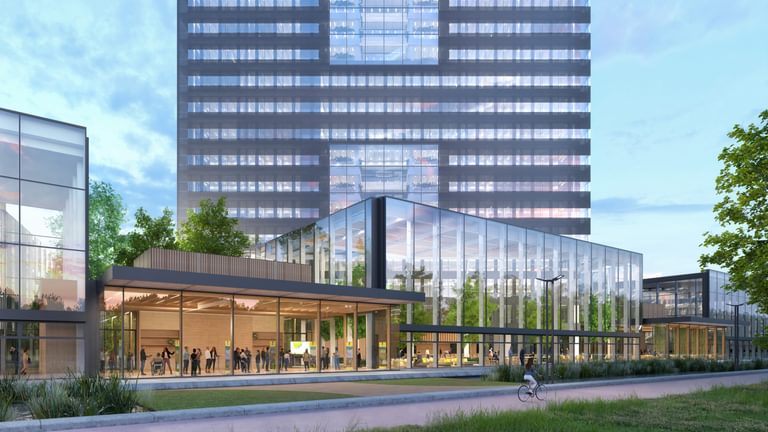Circular construction is sustainable, that much is clear. On Friday 21 June, cepezed organised a knowledge event in Utrecht to define more sharply where we stand. What is needed now remains somewhat diffuse, but regardless, the work of architects and demolishers will change in the 'next step'.
cepezed is well versed in circularity and wants to share its knowledge. That is why the office organised a knowledge event in Westraven. This Utrecht office of Rijkswaterstaat is on the eve of a large, circular renovation, for which cepezed made the design. Led by Ronnie Overgoor, Majorie Jans of the Rijksvastgoedbedrijf, Menno Rubbens of cepezedprojects and Ronald Schleurholts of architectenbureaucepezed gave a short lecture followed by a short plenary discussion. The 70 or so attendees were people from the profession, including engineers, (technical) consultants, builders and some clients.
12 million square metres
At the State Property Agency, circularity is high on the agenda. It is seen as one of the ways to be Paris Proof by 2050. Majorie Jans: 'We either build sustainably or we don't.' She makes it clear how big the impact of that choice can be, given the number of square metres - 12 million - and the number of buildings owned by the State Property Agency. These include government offices, barracks, prisons, courts, palaces, registration centres et cetera. The exemplary role of the State Property Company also drives this ambition.
To meet its own targets, the State Property Agency has drawn up a roadmap. This provides immediately applicable, minimal interventions and targets to be achieved at 'strategic moments', such as 50 per cent less primary raw materials. Jans outlines the sustainability task as an ecosystem, where everything is connected to everything else. 'That is why it is important to know each other and what everyone is doing, which can be done through afternoons like this.'
'we started circular construction a long time ago'



reverse constructionRijksvastgoedbedrijf also sets the tone in its tenders, rewarding guts and commitment and exploring the boundaries of explicit tasks with frontrunners. The tender for the Temporary Court in Amsterdam, for example, explored how to prevent waste in construction - the answer was a remountable building. Five floors of the Maastoren in Rotterdam are all about reuse, here one floor was kept empty to store reusable building elements and furniture. Kantoor Vol Afval in Katwijk focused on capitalising on all opportunities in the field of circularity. Jans calls it 'a kind of reverse construction' because there was no material yet, but there was a design.
The Rijksvastgoedbedrijf formulated a preferred sequence: conservation first, then reuse on site, reuse from elsewhere and biobased new material, and lastly other new material. Which sounds easier than it is, given Jans' recommendation to make sure everyone knows they are in an innovation process, and offer a practical way of working. Suggestions from the room are also mainly practical. A Boei inventory might be useful to know what materials, usable or not, are in a building? And clients may be more creative in the tender and more flexible once a contract is awarded.
the circle is complete
On the urgency of the task, Menno Rubbens singles out the CO2 burden of construction. 'In the Netherlands, construction is responsible for 11 per cent of CO2 emissions, so changes in construction have serious impact. This concerns only material-related emissions in construction, i.e. logistics, where there is also something to be gained. But if we want to meet the Paris target, emissions have to go from 250 to 50 within 26 years, we won't succeed.'
To still get far in this respect, or be ready for the future, Menno Rubbens advocates architecture that can 'handle uncertainty', both in the layers of the building and as a whole. The goal is to finish as high as possible on the R-ladder. 'The best is, of course, to do nothing, so refuse. But if you do build, increase the circular potential in your new buildings, for example with reusable hollow core slabs - reuse.' In his talk, Rubbens also points to the importance of collaboration. As for roles or direction, which was the subject of questions after Jans' presentation, he points out that the circle is circular, 'so anyone can step in anywhere'.


reframeVia the examples of the Circular Centre Heerde, the Cultural Centre Oss, the temporary Rechtbank Amsterdam and the dismantling and reuse of the ABN-Circle building, Menno Rubbens arrives at the concept of 'reframe', the R he would like to add to the R-ladder, just below refuse and rethink. With cepezedprojects, Rubbens wants to fully commit to reframe, or reuse parts of a building.
Luc Vermeijden (Prince Cladding Obdam) notes that his company's circular projects are substantially more expensive because they involve more labour. Circular construction does not become cheaper by doing it more often, Rubbens believes, but by adopting a different value model, with a longer timeframe. 'It's time for developers, architects and builders to take responsibility for the long term instead of only until the moment of completion.'
Other comments from the room are about reusable materials: where do you leave this, for example, if you don't collaborate within a brief? And could the standard be slightly lowered on what you accept with each other, so that sandwich panels with scratches are also included? To the conversation about costings, which follows, Rubbens adds that second-hand channel boards are currently more expensive, because more desirable, than new ones. This is because they are better cured and therefore stronger.
loose design attitude
Ronald Schleurholts recognises Jans' notion of 'reverse building'. He calls it a 'puzzle' and stresses the importance of a 'connector' in the design of a circular building. This is a spatial-constructive element that allows for the gradual incorporation of harvested material without compromising the main structure. Schleurholts finds his profession becoming more fun and complex, "there is more to consider and dismantlers - they used to be called demolishers - already involved at the beginning of the design process".
The examples he shows, including the two renovations of Westraven - the first detachable, the second a shuffle of those elements -, the West Betuwe town hall, pavilion The Green House in Utrecht and the Squadron building in Den Helder make it clear how much experience cepezed already has with circular construction, with Schleurholts touching on what the firm has learned in the process, such as the importance of reusing the main load-bearing structure, which has the most impact in terms of sustainability.
Schleurholts indicates that cepezed's style may not be 'loose', but this does not mean that everything has to be tightly finished. The Green House, for instance, required 'fillers', which were left in sight, and this building, with reused wood and reused paving bricks and smoked-glass façade panels, has the character of a collage. 'There are circular buildings in all sorts of handwriting.' What particularly appeals to him is that as an architect you have to think more loosely, 'it doesn't necessarily have to be what you thought of beforehand'.


demolition ban
'The question regarding circularity is no longer where to start,' Majorie Jans says in conclusion, 'because we have long since started.' However, she does encourage seeking each other out, thinking across borders and, above all, encouraging and challenging each other. 'It goes in small steps, het beton akkoord' signed last week is a step towards circular concrete.' Menno Rubbens concludes the afternoon by calling for a demolition ban, which involves betting on reuse from the outset and starting from the material. Overgoor: 'Demolishers will then get other work.' Rubbens: 'Architects too.'
more with less
One theme that still needs tightening up is the role of other governments and government agencies, outside the national real estate company. There were also questions about costs, storage of circular materials, and product innovation. Clarity is needed in those areas. Perhaps the most interesting was the problem that was raised in relation to the current building task: if we complete that task circularly, the harvest will be insufficient, because more buildings are needed than there are today. We must therefore, as Ronald Schleurholts put it, "do more with less.
discover@cepezed is a series of knowledge events on sustainability themes in construction and architecture, based on the idea that you get further together than alone.
→ Mail bd@cepezed.nl or call our business development team on +31 (0)15 2150000